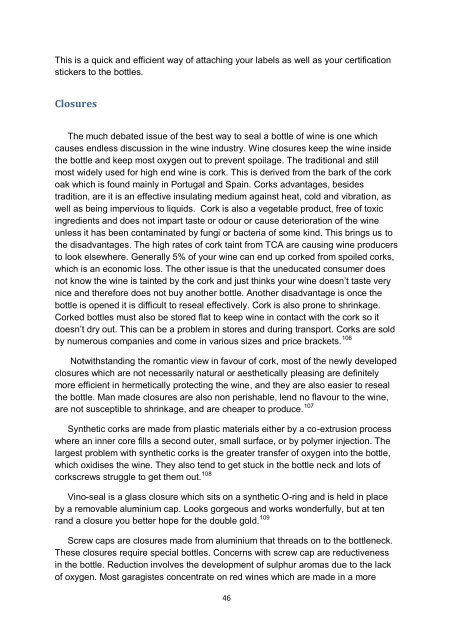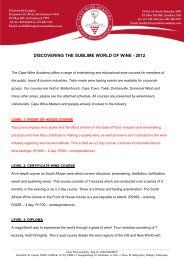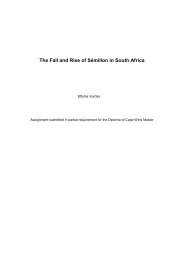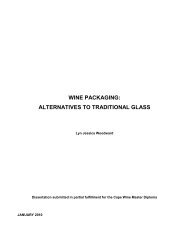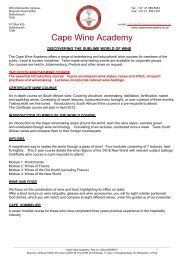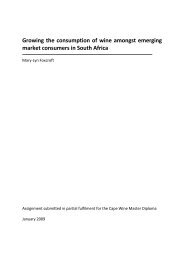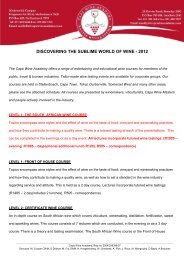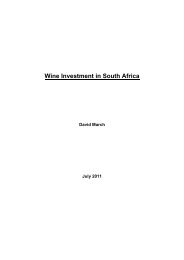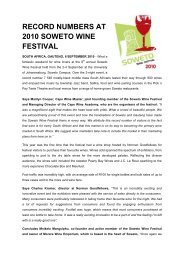Garage Winemaking in South Africa Less is More - Cape Wine ...
Garage Winemaking in South Africa Less is More - Cape Wine ...
Garage Winemaking in South Africa Less is More - Cape Wine ...
You also want an ePaper? Increase the reach of your titles
YUMPU automatically turns print PDFs into web optimized ePapers that Google loves.
Th<strong>is</strong> <strong>is</strong> a quick and efficient way of attach<strong>in</strong>g your labels as well as your certification<br />
stickers to the bottles.<br />
Closures<br />
The much debated <strong>is</strong>sue of the best way to seal a bottle of w<strong>in</strong>e <strong>is</strong> one which<br />
causes endless d<strong>is</strong>cussion <strong>in</strong> the w<strong>in</strong>e <strong>in</strong>dustry. W<strong>in</strong>e closures keep the w<strong>in</strong>e <strong>in</strong>side<br />
the bottle and keep most oxygen out to prevent spoilage. The traditional and still<br />
most widely used for high end w<strong>in</strong>e <strong>is</strong> cork. Th<strong>is</strong> <strong>is</strong> derived from the bark of the cork<br />
oak which <strong>is</strong> found ma<strong>in</strong>ly <strong>in</strong> Portugal and Spa<strong>in</strong>. Corks advantages, besides<br />
tradition, are it <strong>is</strong> an effective <strong>in</strong>sulat<strong>in</strong>g medium aga<strong>in</strong>st heat, cold and vibration, as<br />
well as be<strong>in</strong>g impervious to liquids. Cork <strong>is</strong> also a vegetable product, free of toxic<br />
<strong>in</strong>gredients and does not impart taste or odour or cause deterioration of the w<strong>in</strong>e<br />
unless it has been contam<strong>in</strong>ated by fungi or bacteria of some k<strong>in</strong>d. Th<strong>is</strong> br<strong>in</strong>gs us to<br />
the d<strong>is</strong>advantages. The high rates of cork ta<strong>in</strong>t from TCA are caus<strong>in</strong>g w<strong>in</strong>e producers<br />
to look elsewhere. Generally 5% of your w<strong>in</strong>e can end up corked from spoiled corks,<br />
which <strong>is</strong> an economic loss. The other <strong>is</strong>sue <strong>is</strong> that the uneducated consumer does<br />
not know the w<strong>in</strong>e <strong>is</strong> ta<strong>in</strong>ted by the cork and just th<strong>in</strong>ks your w<strong>in</strong>e doesn‟t taste very<br />
nice and therefore does not buy another bottle. Another d<strong>is</strong>advantage <strong>is</strong> once the<br />
bottle <strong>is</strong> opened it <strong>is</strong> difficult to reseal effectively. Cork <strong>is</strong> also prone to shr<strong>in</strong>kage.<br />
Corked bottles must also be stored flat to keep w<strong>in</strong>e <strong>in</strong> contact with the cork so it<br />
doesn‟t dry out. Th<strong>is</strong> can be a problem <strong>in</strong> stores and dur<strong>in</strong>g transport. Corks are sold<br />
by numerous companies and come <strong>in</strong> various sizes and price brackets. 106<br />
Notwithstand<strong>in</strong>g the romantic view <strong>in</strong> favour of cork, most of the newly developed<br />
closures which are not necessarily natural or aesthetically pleas<strong>in</strong>g are def<strong>in</strong>itely<br />
more efficient <strong>in</strong> hermetically protect<strong>in</strong>g the w<strong>in</strong>e, and they are also easier to reseal<br />
the bottle. Man made closures are also non per<strong>is</strong>hable, lend no flavour to the w<strong>in</strong>e,<br />
are not susceptible to shr<strong>in</strong>kage, and are cheaper to produce. 107<br />
Synthetic corks are made from plastic materials either by a co-extrusion process<br />
where an <strong>in</strong>ner core fills a second outer, small surface, or by polymer <strong>in</strong>jection. The<br />
largest problem with synthetic corks <strong>is</strong> the greater transfer of oxygen <strong>in</strong>to the bottle,<br />
which oxid<strong>is</strong>es the w<strong>in</strong>e. They also tend to get stuck <strong>in</strong> the bottle neck and lots of<br />
corkscrews struggle to get them out. 108<br />
V<strong>in</strong>o-seal <strong>is</strong> a glass closure which sits on a synthetic O-r<strong>in</strong>g and <strong>is</strong> held <strong>in</strong> place<br />
by a removable alum<strong>in</strong>ium cap. Looks gorgeous and works wonderfully, but at ten<br />
rand a closure you better hope for the double gold. 109<br />
Screw caps are closures made from alum<strong>in</strong>ium that threads on to the bottleneck.<br />
These closures require special bottles. Concerns with screw cap are reductiveness<br />
<strong>in</strong> the bottle. Reduction <strong>in</strong>volves the development of sulphur aromas due to the lack<br />
of oxygen. Most garag<strong>is</strong>tes concentrate on red w<strong>in</strong>es which are made <strong>in</strong> a more<br />
46


